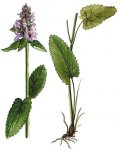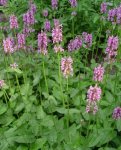Initial letter of medicinal - betonica officinalis l.
Family of labial flowers - Lamiaceae (Labiatae)
Botanical characteristics. Perennial herbaceous plant. It grows in meadows, fringes, among bushes.
Stem is 4-faceted to 60 cm high. Leaves petiolate oblong-ovate. Flowers large irregular shape, sessile in the axils of the leaves polumutovkami. Inflorescence spicate, reddish pink. Seeds are small. Blossoms in May - June, fructifies in July - August.
Spread. It is widely distributed in the forest and forest-steppe zones of Russia, it forms large thickets on forest edges, among bushes, everywhere it is found as a weed in gardens and orchards.
Used parts of the plant. The medicinal raw material is the whole plant, it is pulled out with a root during flowering, dried at a temperature of no higher than 45 ° C in dryers or in the shade outdoors.
Chemical composition. The plant contains essential oil; Iridoidy: harpagid, acetylharpagid, saponins; Steroids: sitosterol; Diterpenoids: phytol; Triterpoeids: bamirin; Alkaloids: stachidrine; Nitrogen-containing compounds: betaine, betonycin, turicin, choline; Phenocarboxylic acids: chlorogenic, gakumaric, coffee; Flavonoids: apigenin; Pigments, vitamins, tannins. Seeds contain fatty oil, in its composition acids: palmitic, stearic, oleic, linoleic, linolenic, microelements.
Application. The letter is widely used in folk medicine of many countries. Infusions and decoctions of roots and aerial parts of plants are used for cardiovascular diseases, pulmonary tuberculosis, liver and stomach diseases, for digestion, gout, rheumatism, acute respiratory infections, bronchitis, bronchial asthma, whooping cough, nephritis, cystitis, neurasthenia, dizziness , Headache, with craniocerebral injuries, epilepsy, neuroses. Above-ground part - in obstetric-gynecological practice - in pregnancy complicated by kidney disease, anemia, with glomerulonephritis (in combination with violet trichrome and poplar), scrofululosis, flatulence; Externally - with wounds, tumors in the chest, convulsions, detoxification - with bites of rabid animals; Fresh leaves - as a wound-healing agent; Infusion of flowers and leaves - with stroke, hysteria, headache, fainting, eye diseases. Seeds - in the form of a powder and broth for impotence.
In the experiment, the capsule preparations have a pronounced choleretic, anti-inflammatory, soothing, analgesic, laxative, antifungal effect, increase blood circulation, and display an antibacterial function.
Preparation
- For infusion take 20 g of leaves, flowers or a mixture of them, pour 200 ml of boiling water, insist on a boiling water bath for 15 minutes, cool for 45 minutes, filter. Take 1/3 cup 2-3 times daily before meals.
- For decoction 15 g roots of the aboveground part of the plant or seeds are poured 200 ml of boiling water, insist on a boiling water bath for 30 minutes, cool for 10 minutes, filter. Take 1 tbsp. Spoon 3-4 times a day before meals.
- Tincture from the roots or aboveground part of the plant is prepared on 70% alcohol at a rate of 1: 5, insist in a dark place for 10-12 days, filter. Take 30-40 drops per reception 3 times a day before meals.
Contraindications. The letter is contraindicated in pregnancy, as, according to experimental data, it contributes to an increase in the tone of the uterus.




Comments
Commenting on, remember that the content and tone of your message can hurt the feelings of real people, show respect and tolerance to your interlocutors even if you do not share their opinion, your behavior in the conditions of freedom of expression and anonymity provided by the Internet, changes Not only virtual, but also the real world. All comments are hidden from the index, spam is controlled.